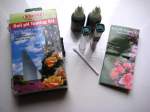Home › Garden lawns › Lawn maintenance
Lawn Maintenance
How To Keep Your Lawn In Great Condition
Lawn maintenance can be a confusing subject so the following is a quick guide to the lawn care tasks that need doing and the best time to carry them out.
If you're not sure what equipment you will need, I've also put together tips and information on selecting the right lawn care tools.
Of course it goes without saying that the single most important task, and the one that you (or someone else if you're lucky) will spend most time doing, is cutting the grass.
Therefore there are separate pages devoted to mowing a lawn and choosing the best lawnmower.
Lawn Maintenance: Edging
Few things are more satisfying than a mown lawn with a neatly defined edge. Edging your lawn really does make a huge difference to its appearance as well as preventing lawn grasses from spreading into your borders.
For the best results you will need to do two things: define the lawn edges by re-cutting, and keep them trimmed throughout the growing season.
Defining the Lawn Edge
Over the course of the year the edges of your lawn tend to spread and become ragged so it's important to re-cut them to give a crisp, clearly defined finish. This only usually needs doing once a year in the spring.
Trimming the Lawn Edge
Once you've defined the edges of your lawn it's a simple matter to keep them looking their best by regularly trimming the overhanging grass. If you do it every time you mow it doesn't take too long and the clean, crisp finish more than justifies the extra effort.
Lawn Maintenance: Scarifying and Aerating
These are methods of opening up the surface of the lawn to allow air to penetrate and circulate. This encourages deeper root growth and promotes a denser lawn.
There are two processes involved: scarifying to remove the layer of dead grass or 'thatch' that builds up over time, and aerating to make holes in the soil surface.
Scarifying
Over time, dead grass, or thatch, accumulates at the base of your lawn and effectively chokes the grass causing a noticeable decline in quality. Scarifying is the process of raking the lawn surface to remove the thatch and any dead moss or other debris. It is best done in early to mid autumn.
Aerating
This is the process of making thin, deep holes in the surface of your lawn. This allows air penetration, encourages deeper root growth, and improves drainage by reducing compaction.
If possible aerate the whole lawn in early to mid autumn. Areas subject to heavy wear may benefit from additional spiking in mid to late summer.
Lawn Maintenance: Feeding and Fertilizing
Most lawns benefit from some additional feeding twice a year to keep them looking their best. It is usual to apply a specially formulated lawn fertilizer containing nitrogen (N), phosphorus (P), potassium (K) and iron (Fe).
Nitrogen is particularly important as it is needed to fuel the growth stimulated by mowing. Although grass clippings contain nitrogen, these are usually cleared away and added to the compost heap so your lawn doesn't get the benefit (although the rest of your garden does!).
You can tell if your lawn is short of nitrogen because it will turn a rather yellowish green.
Lawn feeds are available in different formulations depending on the time of year they are to be applied so make sure you use the right one at the right time.
In late spring to early summer you need a fertilizer that is higher in nitrogen.
In autumn use a formulation that has less nitrogen as at this time of the year you may end up with soft growth that will encourage mould and fungal diseases.
Lawn Maintenance: Top Dressing
Top dressing used to be considered absolutely essential but nowadays many people don't bother. It is worth doing if you have a high quality lawn or if you want to improve the quality of your utility lawn.
Top dressing involves spreading a mixture of six parts medium-fine sand, three parts sieved soil and one part peat substitute or leaf mould evenly over the surface of your lawn. You can either make up your own mix or buy one ready prepared.
Applying a top dressing helps to maintain the benefits of aeration and also levels out minor irregularities in the surface.
It is best carried out after you have finished the rest of the autumn maintenance tasks.
Lawn Maintenance: Sweeping Leaves
In autumn and winter any fallen leaves should be swept or raked up and removed as a thick layer of leaves will keep out the air and encourage disease.
Find more information at these related Lawn and Lawn Care pages
Now that you have a good idea of the regular tasks involved in caring for your lawn, take a few minutes to read the information about selecting and using the right lawn care tools for each task so that you can decide which you will really need before you buy.
If your lawn is less than ideal, there is also a section devoted to common lawn problems and how to resolve them.
You will find more information about garden lawns, together with links to other lawn-related pages, at garden lawns.
Home › Garden lawns › Lawn maintenance
